DENON DJ MC-4000
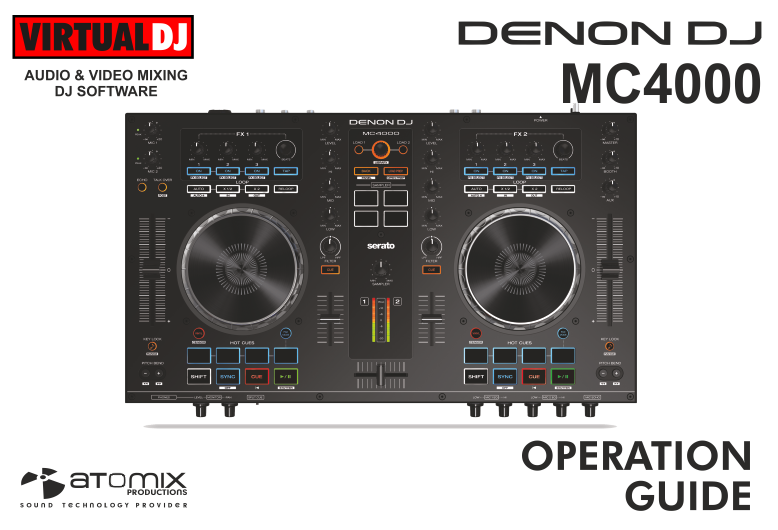
SETUP
Connections
Use the included power adapter (6V DC, 3A, center-positive) to connect MC4000 to a power outlet. Connect the unit’s USB socket with a USB port of your computer. Connect a pair of amplified speakers or amplifier to the Master Output sockets (RCA or XLR). Power on MC4000.
Firmware & Drivers
Firmware: (Windows & Mac)
Currently there is no firmware available, but please make sure of that by visiting the Denon Support page. https://www.denondj.com/downloads
Drivers (Windows only)
Download and install the latest ASIO drivers from: https://www.denondj.com/downloads
No drivers need to be installed for Mac OSX computers
VirtualDJ Setup
Once VirtualDJ is launched, a Connect Window will appear. Login with your virtualdj.com account’s credentials.
A Pro Infinity, a PLUS or a Pro Subscription License is required to use the Denon DJ MC4000. Without any of the above Licenses, the controller will operate for 10 minutes each time you restart VirtualDJ.
https://www.virtualdj.com/buy/index.html

Select “MC4000” and click OK
Speakers need to be connected to the rear panel of the MC4000 in this case.

The unit is now ready to operate with VirtualDJ.
MIDI Operation
The unit should be visible in the MAPPING tab of Config and the “factory default” available/selected from the Mappings drop-down list.
The factory default Mapping offers the functions described in this Manual, however those can be adjusted to your needs via VDJ Script actions.
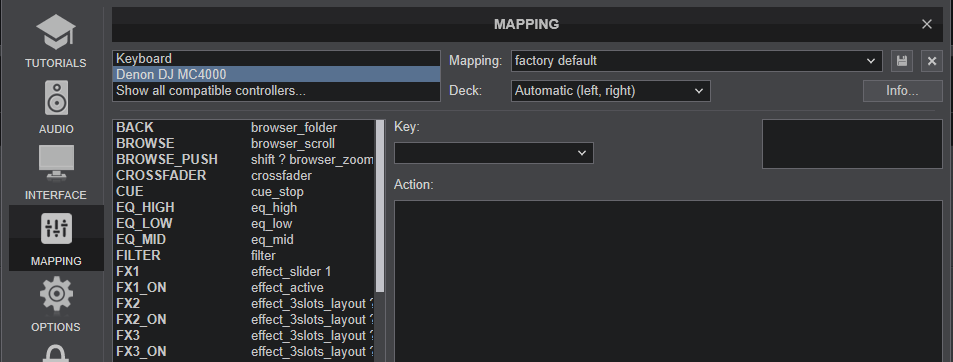
Find more details at
http://www.virtualdj.com/wiki/VDJ8script.html
AUDIO SETUP
The unit has a pre-defined Audio setup and a special button in the AUDIO tab of Config to provide that.
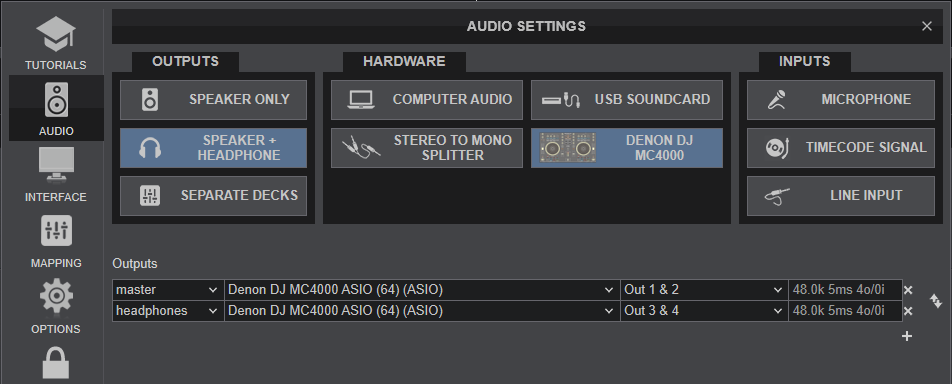
See also Inputs & Recording.
Please read the manual of the unit for further connections/capabilities.
http://denondj.com/products/view/mc4000
For further software settings please refer to the User Guide of VirtualDJ 8.
https://www.virtualdj.com/manuals/virtualdj8/index.html
LAYOUT

S. SHIFT. Press and hold this button to access secondary functions of other controls on the MC4000
M. PAD MODE. Press and hold this button to access a different mode for the HotCue PADS or Sampler PADS
MIXER
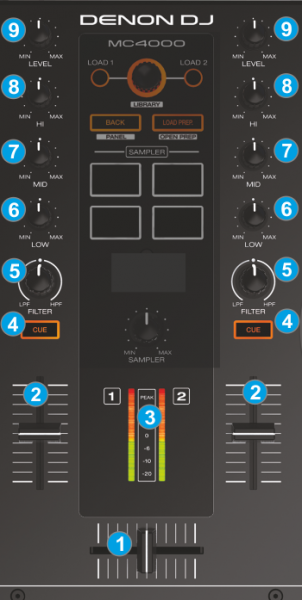
- CROSSFADER. Blends audio between the left and right decks
- VOLUME. Use these faders to adjust the Volume of each deck.
- VU METERS The Led Meters indicate the Output Level of each deck
- CUE/PFL. Press these buttons to send this deck's pre-fader signal to the Cue Channel for monitoring. When engaged, the button will be lit.
- FILTER. Use these knobs to apply a High/Low Pass Filter on the left/right decks.
- EQ LOW. Adjusts the low (bass) frequencies of each deck.
- EQ MID. Adjusts the middle (mid) frequencies of each deck
- EQ HIGH. Adjusts the high (treble) frequencies of each deck
- GAIN. Adjusts the audio level (gain) of the corresponding deck
* Note: The device is offering Full Stems controls. See details at EQ Modes
BROWSER
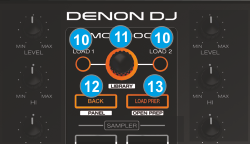
- LOAD. Use these buttons to load the selected track from the Browser to the left or right deck. Hold the same button for more than 2 seconds to unload the same deck.
Hold SHIFT down and then use these buttons to clone the deck to the opposite one. - LIBRARY. Use this encoder to scroll through Folders or Files. Hold SHIFT down and use this encoder to scroll faster (+/- 10 tracks per step). Push the encoder to set focus to the Songs List.
- BACK Use this button to set focus to the Folders List. If the focus is on the Folders list, use this button to expand/collapse sub-folders.
Hold SHIFT down and then use this button to cycle through the available center panels of the default GUI of VirtualDJ (Mixer, Video, Scratch an Master view)
- LOAD/PREP. Press this button to add the selected track to the Automix List of Sideview.
Hold SHIFT down to set focus to Sideview.
If focus is on the Sideview hold SHIFT down and then use this button to cycle through the Sideview windows (Automix, Sidelist, Karaoke, Sampler and Shortcuts)
Hold SHIFT down and press this button for more than 2 seconds to open/close the Sideview.
SAMPLER

- SAMPLER BUTTONS. Use these buttons to trigger Samples 1 to 4 of the selected Sampler Bank of VirtualDJ.
Hold down any of the PAD MODE buttons (M) and then use the left Sampler buttons to select the previous and next Sampler Bank.
Hold down any of the PAD MODE button (M) and then use the right Sampler buttons to select the previous and next Sampler trigger mode (On/Off, Stutter, Hold and Unmute)
Depending on the selected Sampler mode, hold SHIFT down and then use the same Sampler buttons to stop the playing samples. - SAMPLER VOLUME. Use this knob to adjust the Master Volume of the Sampler (will affect the Output Volume of all Samples)
DECK CONTROLS
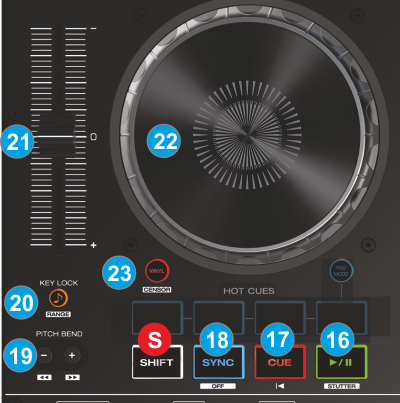
- PLAY. Plays / Pauses the track. Press and hold SHIFT and then press this button to "stutter-play" the track from the last set Cue Point.
- CUE. When the Deck is paused, you can set a temporary Cue Point by moving the Platter to place the Audio Pointer at the desired location and then pressing the Cue Button.
During playback, you can press the Cue Button to return the track to this Cue Point. (If you did not set a Cue Point, then it will return to the beginning of the track.).
If the Deck is paused, you can press and hold the Cue Button to play the track from the Temporary Cue Point. Releasing the Cue Button will return the track to the temporary Cue Point and pause it.
To continue playback without returning to the Temporary Cue Point, press and hold the Cue Button, then press and hold the Play Button, and then release both buttons.
Press and hold SHIFT and then press this button to return to the beginning of the track. - SYNC. Press this button to automatically match the corresponding Deck's tempo and phase with the opposite Deck's (or the Master Deck’s if using a 4 decks Skin) tempo and phase. Hold SHIFT down and then press this button to set this deck as Master Deck (for 4 decks skins).
- PITCH BEND. Press and hold these buttons down to temporary speed up/slow down the song while pressed. When released, the track playback will return to the speed designated by the Pitch Fader.
Hold SHIFT down and then use these buttons to move the track forward or backwards by 8 beats (seek) - KEYLOCK. Press this button to "lock" the track's pitch to its original key. The track's tempo will remain at the speed designated by the Pitch Fader.
Hold SHIFT down and then use this button to select the next available range of the Pitch Fader ( from ±6%, ±8%, ±10%, ±12%, ±20%, ±25%, ±33%, ±50% to ±100%). - PITCH. Adjust the track's playback speed (tempo).
- JOG. Touch sensitive jogwheel. Use the jogwheel to scratch (if Vinyl mode is selected) or pitch bend. The Jogwheel also offers Loop In and Loop Out point adjustment (see Effects & Loops)
Hold SHIFT down and then use the jogwheel to fast seek through track. - SCRATCH. Press this button to set the Jogwheel to Vinyl (Scratch) or CD (Bend) mode. In Vinyl mode, use the outer part of the Jogwheel to bend (temporary speed up – slow down the tempo of the track).
Hold SHIFT down and then keep this button down to play the track in reverse. When the button is released, the track will continue playing from the position it would have been if never used (CENSOR).
PADS

- PADS. The 4 Pads offer 4 different modes, depending on the PAD MODE selection button (M).
Hold the PAD MODE button down and then press one the 4 Pads to select a mode as per the image.
HotCues 1-4 mode
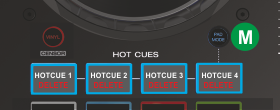 Hold the PAD MODE button (M) down and then press Pad Nr1 button to select the HotCues 1-4 mode. The LED of the PAD MODE selection button will be turned off after the selection.
Hold the PAD MODE button (M) down and then press Pad Nr1 button to select the HotCues 1-4 mode. The LED of the PAD MODE selection button will be turned off after the selection.Each one of the 4 Pads assigns a Hot Cue Point (1 to 4) or returns the track to that Hot Cue Point.
When a Pad is unlit, you can assign a Hot Cue Point by pressing it at the desired point in your track. Once it is assigned, the Hot Cue Button will light up blue.
Hold SHIFT and then press any of the 4 Pads to delete its assigned Hot Cue Point.
HotCues 5-8 mode
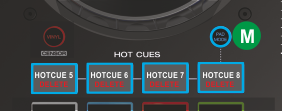 Hold the PAD MODE button (M) down and then press Pad Nr2 button to select the HotCues 5-8 mode. The LED of the PAD MODE selection button will be turned on blue after the selection.
Hold the PAD MODE button (M) down and then press Pad Nr2 button to select the HotCues 5-8 mode. The LED of the PAD MODE selection button will be turned on blue after the selection.Same as the HotCues 1-4 mode, each one of the 4 Pads assigns a Hot Cue Point (5 to 8) or returns the track to that Hot Cue Point.
When a Pad is unlit, you can assign a Hot Cue Point by pressing it at the desired point in your track. Once it is assigned, the Pad will light up blue.
Hold SHIFT and then press any of the 4 Pads to delete its assigned Hot Cue Point.
Hot Loop 1-4 mode
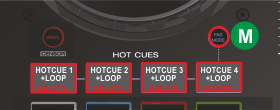 Hold the PAD MODE button (M) down and then press Pad Nr3 button to select the Hot-Loops 1-4 mode. The LED of the PAD MODE selection button will be turned on red after the selection.
Hold the PAD MODE button (M) down and then press Pad Nr3 button to select the Hot-Loops 1-4 mode. The LED of the PAD MODE selection button will be turned on red after the selection.Each one of the 4 Pads assigns a Hot Cue Point (1 to 4) or returns the track to that Hot Cue Point, but in both cases, it also triggers a Loop.
The currently selected length will be used for the triggered Loop
While loop is triggered, press the same Pad to disable the Loop.
The LED of the Pad will turn red if the HotCue is assigned and will flash while the loop is triggered.
Hold SHIFT down and then press a pad to delete its assigned Hot Cue Point.
Use the LOOP HALF and LOOP DOUBLE buttons (38) to half and double the size of the applied Loop.
Loop Rolls mode
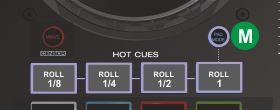 Hold the PAD MODE button (M) down and then press Pad Nr4 button to select the Loop Rolls mode. The LED of the PAD MODE selection button will be turned on purple after the selection.
Hold the PAD MODE button (M) down and then press Pad Nr4 button to select the Loop Rolls mode. The LED of the PAD MODE selection button will be turned on purple after the selection.Each one of the 4 Pads triggers a momentary (while pressed) Loop Roll of a different size in beats as per the image.
Once the Pad is released, the track will continue to play from the position it would have been if the Loop was never triggered.
EFFECTS & LOOPS
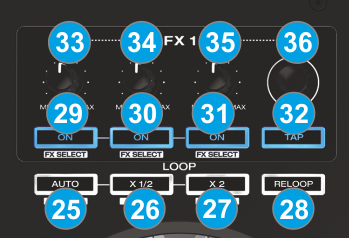
Loops
- AUTO. Use this button to enable/disable a Loop of a pre-selected length in beats. The LED of this button will blink if a Loop is enabled.
Hold SHIFT down and then use this button to enable/disable a Loop of 4 beats length - HALF. Use this button to half the size in beats of the pre-selected Auto-Loop
Hold SHIFT down and then use this button to set a Loop In (Entry) point for manual looping.
While a Loop is triggered, hold SHIFT down and then use this button to set the jogwheel to Loop-In mode (led will blink) and fine adjust the Loop-In point using the jogwheel. - DOUBLE. Use this button to double the size in beats of the pre-selected Auto-Loop
Hold SHIFT down and then use this button to set a Loop Out (Exit) point for manual looping.
While a Loop is triggered, hold SHIFT down and then use this button to set the jogwheel to Loop-Out mode (led will blink) and fine adjust the Loop-Out point using the jogwheel. - RELOOP. Use this button to trigger the last triggered Loop (Reloop)
Hold SHIFT down and then use this button to enable/disable the Loop Roll mode (led will blink when enabled). When the Loop Roll mode is enabled the Loops will act temporary and when exit, the track will continue playing from the position it would have been if the Loop was never triggered.
Effects
Both Effect units (on the left and right side) offer 2 different modes and controls for the Effects applied on the corresponding deck.
Hold SHIFT down and then press the TAP (32) button to toggle between the Single FX and Multi FX effects mode. The LED of the TAP button will be turned on blue if the Multi-FX mode is selected.
The Single FX mode offers a single Effect slot with up to 6 Effect parameters and 2 Effect Buttons.
The Multi FX mode offers 3 Effect slots with up to 2 Effect Parameters per slot.
- FX1 ON
Single FX Mode. Press this button to trigger the selected Effect. Hold SHIFT down and then press this button to open/close the FX GUI of the selected Effect.
Multi FX Mode. Press this button to trigger the selected Effect on FX Slot 1. Hold SHIFT down and then press this button to select the next Effect for FX Slot 1. - FX2 ON
Single FX Mode. Press this button to select the previous Effect. Hold SHIFT down and then press this button to enable/disable the 1st Effect button of the Effect (if available).
Multi FX Mode. Press this button to trigger the selected Effect on FX Slot 2. Hold SHIFT down and then press this button to select the next Effect for FX Slot 2. - FX3 ON
Single FX Mode. Press this button to select the next Effect. Hold SHIFT down and then press this button to enable/disable the 2nd Effect button of the Effect (if available).
Multi FX Mode. Press this button to trigger the selected Effect on FX Slot 3. Hold SHIFT down and then press this button to select the next Effect for FX Slot 3. - TAP. Manually adjust the tempo of the song. Tap this button at the same tempo as the track to help the software detect a different BPM reading (if needed). Hold SHIFT down and then use this button to toggle between the Single and Multi FX modes.
- FX1 KNOB.
Single FX Mode. The knob controls the 1st parameter of the selected Effect. Hold SHIFT down and then use this knob to control the 4th parameter of the selected Effect.
Multi-FX Mode: The knobs control the 1st parameter of the selected Effect on FX Slot 1. Hold SHIFT down and then use this knob to control the 2nd parameter of the selected Effect on FX Slot 1. - FX2 KNOB.
Single FX Mode. The knob controls the 2nd parameter of the selected Effect. Hold SHIFT down and then use this knob to control the 5th parameter of the selected Effect.
Multi-FX Mode: The knobs control the 1st parameter of the selected Effect on FX Slot 2. Hold SHIFT down and then use this knob to control the 2nd parameter of the selected Effect on FX Slot 2. - FX3 KNOB.
Single FX Mode. The knob controls the 3rd parameter of the selected Effect. Hold SHIFT down and then use this knob to control the 6th parameter of the selected Effect.
Multi-FX Mode: The knobs control the 1st parameter of the selected Effect on FX Slot 3. Hold SHIFT down and then use this knob to control the 2nd parameter of the selected Effect on FX Slot 3. - BEATS ENC. Use the left BEATS Encoder to select the Video Transition and the right BEATS encoder to select the Video Effect for Master.
Push the left encoder to trigger the selected Video Transition and the right encoder to trigger the selected Master Video Effect.
Hold SHIFT down and then use the left encoder to adjust the 1st parameter of the selected video Transition (if available) and the right encoder to adjust the 1st parameter of the selected Master Video Effect (if available)
Hold SHIFT down and then push the left encoder to open/close the FX GUI of the selected Video Transition and the right one to open/close the FX GUI of the selected Master Video Effect.
MICROPHONE
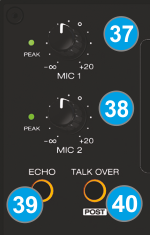
- MIC1 LEVEL. Adjust the gain (input level), of MIC1 Microphone Input
- MIC2 LEVEL. Adjust the gain (input level), of MIC2 Microphone Input
- ECHO. Use this button to enable/disable the Echo Effect on both Microphone Inputs. The amount of the applied Echo Effect is controlled from the front panel of the unit.
- TALK OVER. Use this button to enable/disable Talk Over (led will blink when engaged). When enabled, the MC4000 detects the MIC inputs and attenuates the audio signal level of the master output. When using the microphone, this function prevents the microphone audio from being covered by the music, making speech easier to hear
Hold SHIFT down and use this button to disable/enable MIC Inputs (Announcements) to the Booth Output.
MASTER
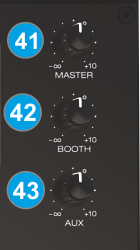
- MASTER VOLUME : Adjusts the Master Output Volume (Hardware operation - movement not visible on the VirtualDJ GUI)
- BOOTH VOLUME. Adjusts the Booth Output Volume (Hardware operation – movement not visible on the VirtualDJ GUI)
- AUX VOLUME. Adjust the gain (input level), of the Auxiliary Input (Hardware Operation – not visible on the VirtualDJ GUI)
REAR PANEL

- POWER: Use included power adapter (6V DC, 3A, center-positive) to connect MC4000 to a power outlet. While the power is switched off, plug the cable into MC4000 first, and then plug the other end into a power outlet. Use the Power Switch to turn the MC4000 on and off. Turn on the MC4000 after all input devices have been connected and before you turn on amplifiers. Turn off amplifiers before you turn off the unit
- USB. This USB connection sends and receives audio and control information from a connected computer.
- BOOTH OUTPUT (TRS): Use standard TRS cables to connect this output to a booth monitoring system. The level of this output is controlled by the Booth knob on the top panel.
- MASTER OUTPUT (XLR): Connect this low-impedance XLR output to a PA system or powered monitors. The level of this output is controlled with the Master knob on the top panel.
- MASTER OUTPUT (RCA): Use standard RCA cables to connect this output to a speaker or amplifier system. The level of this output is controlled by the Master knob on the top panel.
- AUX. Use standard RCA cables to connect this input to an external analogue media source (CD, MPE player etc). The level of this input is controlled by the AUX knob on the top panel.
- MIC2 INPUT. Connect a 1/4" microphone to this input.
- MIC1 INPUT. Connect a 1/4" or a XLR microphone to this input.
FRONT PANEL

- HEADPHONES SOCKET. Connect your 1/4" or 1/8" headphones to this output for cueing and mix monitoring.
- HEADPHONES VOLUME. Adjusts the volume level of the headphone output.
- HEADPHONES MIX: Turn to mix between Cue and Program in the Headphone channel. When all the way to the left, only channels routed to Cue will be heard. When all the way to the right, only the Program mix will be heard.
- HEADPHONES SPLIT. When this switch is in the ON position, the headphone audio will be "split" such that all channels sent to Cue are mixed to mono and applied to the left headphone channel and the Program mix is mixed to mono and applied to the right channel. When the switch is in the OFF position, Cue and Program audio will be "blended" together.
- MIC1 EQ. Adjust the Low and High Frequencies of the Microphone 1 Input channel.
- MIC2 EQ. Adjust the Low and High Frequencies of the Microphone 2 Input channel.
- MIC ECHO. Use this knob to apply an Echo Effect on both Microphone Inputs.
INPUTS & RECORDING
The pre-defined Audio configuration of VirtualDJ 8 for the Denon DJ MC4000 provides the ability to record your mix without any further adjustments.
However, since both Microphone and AUX Inputs of the Denon DJ MC4000 are directly routed to the Master Output of the unit (Hardware Inputs), those cannot be controlled from VirtualDJ nor included in the Audio Setup.
If you wish to record both the software mix and the Inputs (Microphones and Aux) at the same time, you will need to:
- Route the Booth Output of the MC4000 to a Line Input of a different sound card (could be the MIC/LINE Input of your computer’s built-in sound card) using suitable cables
- Add a Record Line to the Audio Setup using the Input of the 2nd sound card.
